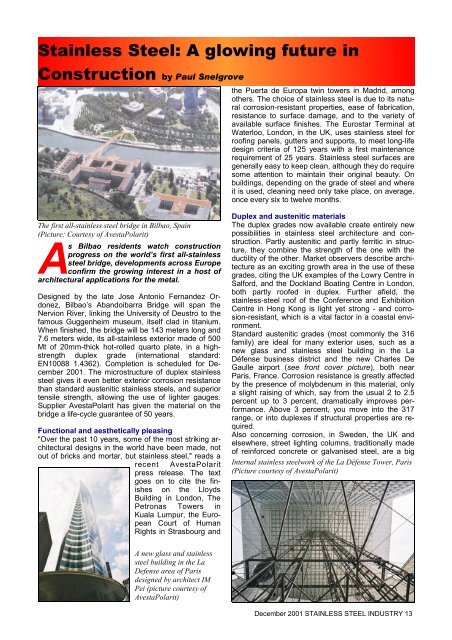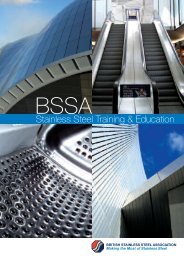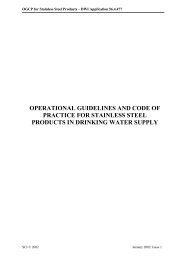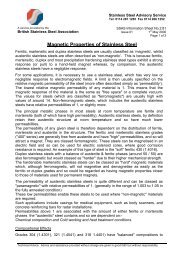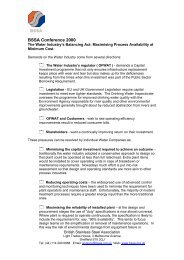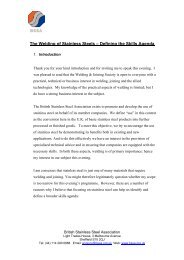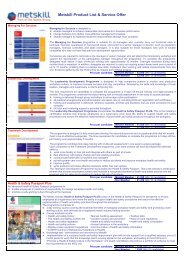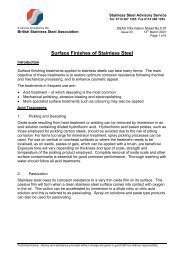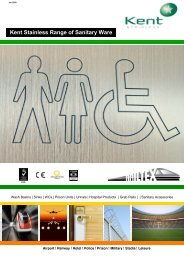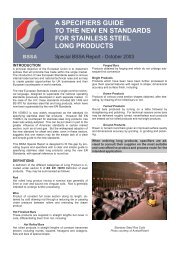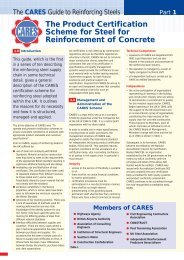A glowing future.pdf - British Stainless Steel Association
A glowing future.pdf - British Stainless Steel Association
A glowing future.pdf - British Stainless Steel Association
Create successful ePaper yourself
Turn your PDF publications into a flip-book with our unique Google optimized e-Paper software.
<strong>Stainless</strong> <strong>Steel</strong>: A <strong>glowing</strong> <strong>future</strong> in<br />
Construction by Paul Snelgrove<br />
the Puerta de Europa twin towers in Madrid, among<br />
others. The choice of stainless steel is due to its natural<br />
corrosion-resistant properties, ease of fabrication,<br />
resistance to surface damage, and to the variety of<br />
available surface finishes. The Eurostar Terminal at<br />
Waterloo, London, in the UK, uses stainless steel for<br />
roofing panels, gutters and supports, to meet long-life<br />
design criteria of 125 years with a first maintenance<br />
requirement of 25 years. <strong>Stainless</strong> steel surfaces are<br />
generally easy to keep clean, although they do require<br />
some attention to maintain their original beauty. On<br />
buildings, depending on the grade of steel and where<br />
it is used, cleaning need only take place, on average,<br />
once every six to twelve months.<br />
The first all-stainless steel bridge in Bilbao, Spain<br />
(Picture: Courtesy of AvestaPolarit)<br />
A<br />
s Bilbao residents watch construction<br />
progress on the world’s first all-stainless<br />
steel bridge, developments across Europe<br />
confirm the growing interest in a host of<br />
architectural applications for the metal.<br />
Designed by the late Jose Antonio Fernandez Ordonez,<br />
Bilbao’s Abandoibarra Bridge will span the<br />
Nervion River, linking the University of Deustro to the<br />
famous Guggenheim museum, itself clad in titanium.<br />
When finished, the bridge will be 143 meters long and<br />
7.6 meters wide, its all-stainless exterior made of 500<br />
Mt of 20mm-thick hot-rolled quarto plate, in a highstrength<br />
duplex grade (international standard:<br />
EN10088 1.4362). Completion is scheduled for December<br />
2001. The microstructure of duplex stainless<br />
steel gives it even better exterior corrosion resistance<br />
than standard austenitic stainless steels, and superior<br />
tensile strength, allowing the use of lighter gauges.<br />
Supplier AvestaPolarit has given the material on the<br />
bridge a life-cycle guarantee of 50 years.<br />
Functional and aesthetically pleasing<br />
"Over the past 10 years, some of the most striking architectural<br />
designs in the world have been made, not<br />
out of bricks and mortar, but stainless steel," reads a<br />
recent AvestaPolarit<br />
press release. The text<br />
goes on to cite the finishes<br />
on the Lloyds<br />
Building in London, The<br />
Petronas Towers in<br />
Kuala Lumpur, the European<br />
Court of Human<br />
Rights in Strasbourg and<br />
Duplex and austenitic materials<br />
The duplex grades now available create entirely new<br />
possibilities in stainless steel architecture and construction.<br />
Partly austenitic and partly ferritic in structure,<br />
they combine the strength of the one with the<br />
ductility of the other. Market observers describe architecture<br />
as an exciting growth area in the use of these<br />
grades, citing the UK examples of the Lowry Centre in<br />
Salford, and the Dockland Boating Centre in London,<br />
both partly roofed in duplex. Further afield, the<br />
stainless-steel roof of the Conference and Exhibition<br />
Centre in Hong Kong is light yet strong - and corrosion-resistant,<br />
which is a vital factor in a coastal environment.<br />
Standard austenitic grades (most commonly the 316<br />
family) are ideal for many exterior uses, such as a<br />
new glass and stainless steel building in the La<br />
Défense business district and the new Charles De<br />
Gaulle airport (see front cover picture), both near<br />
Paris, France. Corrosion resistance is greatly affected<br />
by the presence of molybdenum in this material, only<br />
a slight raising of which, say from the usual 2 to 2.5<br />
percent up to 3 percent, dramatically improves performance.<br />
Above 3 percent, you move into the 317<br />
range, or into duplexes if structural properties are required.<br />
Also concerning corrosion, in Sweden, the UK and<br />
elsewhere, street lighting columns, traditionally made<br />
of reinforced concrete or galvanised steel, are a big<br />
Internal stainless steelwork of the La Défense Tower, Paris<br />
(Picture courtesy of AvestaPolarit)<br />
A new glass and stainless<br />
steel building in the La<br />
Defense area of Paris<br />
designed by architect IM<br />
Pei (picture courtesy of<br />
AvestaPolarit)<br />
December 2001 STAINLESS STEEL INDUSTRY 13
issue today for many city councils. Concrete can crack<br />
and drop off as the inner metal reinforcement rusts<br />
and expands, while steel columns corrode both below<br />
ground and above ground when water seeps inside<br />
posts and damages the galvanising. In the UK alone,<br />
it is estimated that about 3 million outdoor lampposts<br />
will need replacing in the next ten years. Many are urgent.<br />
The industry is promoting the proposition of<br />
stainless steel columns that should last 70 years at<br />
the very least.<br />
<strong>Stainless</strong> steel seeks acceptance as a structural<br />
material<br />
Explaining that the industry is working hard to increase<br />
the structural use of stainless steel, experts<br />
affirm that the physical forming of a stainless steel<br />
tube enhances the material's mechanical properties<br />
(work-hardening), making it actually stronger than carbon<br />
steel. The result requires no coating, painting or<br />
maintenance, so stainless steel can be doubly advantageous<br />
as a strong, lightweight structural member.<br />
Already widely used in door- and window-frames, the<br />
metal can be folded and shaped into elaborate sections,<br />
and ground or brushed for an attractive finish. In<br />
The exterior at North Greenwhich Station (picture courtesy<br />
of EuroInox)<br />
addition, the advantages of stainless steel in terms of<br />
fire resistance are not yet fully exploited, and further<br />
research is needed to assess the material's true potential<br />
here.<br />
Extensive R&D, centred on the behaviour of stainless<br />
steel members and connections, has been carried out<br />
in Europe since 1991. The work culminated in the<br />
publication of the ENV for Eurocode 3 Design of <strong>Steel</strong><br />
Structures - Supplementary Rules for <strong>Stainless</strong> <strong>Steel</strong>s<br />
(EC3: Part 1.4). These rules were, however, adapted<br />
from carbon steel rules. Since the load-bearing capacity<br />
of stainless steel members differs from that of carbon<br />
steel members, further research was required to<br />
define a new design approach and maximise the costeffectiveness<br />
of stainless steel’s desirable properties<br />
in structural uses. A recently completed, partially ECfunded,<br />
three-year research project, involving major<br />
producers and other organisations from six European<br />
countries, is now being followed up by a valorisation<br />
project that updates the old design manual for<br />
stainless steel. The project will also ensure wide dissemination<br />
of the latest findings (partly through electronic<br />
media) among architects and structural engineers.<br />
Wall cladding at Souhwark<br />
station (picture courtesy of<br />
EuroInox)<br />
<strong>Stainless</strong> steel for architects<br />
"Handrails and parapets<br />
were rare 20 years ago,<br />
but have become almost<br />
standard nowadays," explains<br />
Thomas Pauly of<br />
Euro-Inox, the European<br />
stainless steel market<br />
development association.<br />
"Interior cladding is a big<br />
growth area as well, being<br />
easily maintained and<br />
attractive. The extension<br />
to London’s Jubilee Line<br />
subway, for example,<br />
uses it extensively," he<br />
adds. Architects tend to<br />
worry about fingerprint<br />
soiling, but very robust embossed<br />
and pattern-rolled finishes exist which are less<br />
sensitive to fingerprints. These are much used for elevators<br />
and escalators in stations, hotels and airports.<br />
"<strong>Stainless</strong> steel has both practical and decorative<br />
merits and elevators and escalators are amongst the<br />
biggest markets for flat products," says Mr. Pauly.<br />
<strong>Stainless</strong> steel facades in architecture go back to the<br />
1950s. The electricity substation at the Elephant and<br />
Castle traffic circle in London dates from that time<br />
and, despite pollution, is still in fine condition. “Now<br />
we can make stainless steel facades at the same cost<br />
as with other materials, so there is huge development<br />
potential,” Mr. Pauly points out. <strong>Stainless</strong> steel roofing<br />
has been around for 30 years, but is set to grow.<br />
There is an obvious trend towards metallic materials<br />
on buildings, especially for decorative purposes, and a<br />
swing back from the “disposable architecture” philosophy<br />
to greater construction quality and durability.<br />
“With stainless steel you don’t get corrosion, even under<br />
difficult circumstances, and whatever you combine<br />
it with it won’t corrode, so its durability is exceptional,”<br />
says Mr. Pauly. Ecologists like it, too, since stainless<br />
steel is neutral to the environment and does not result<br />
in noxious substances getting into the water table.<br />
Switzerland, Austria and parts of France and Germany<br />
have a long tradition of metallic roofing, and the<br />
architects in these Alpine areas readily use stainless<br />
steel. There are two approaches. One is the welded<br />
stainless steel roof, which is a 100-percent watertight<br />
solution, useable on a flat roof, and the other is the<br />
conventional standing seam roof, which can be built<br />
by any roofing contractor. “This is now a very large,<br />
potential market throughout Europe, which we are trying<br />
hard to promote,” underlines Mr. Pauly.<br />
<strong>Stainless</strong> steel in tunnel and road applications<br />
Tunnel linings are an interesting growth area. Alpine<br />
countries use it a lot, often in short tunnels, which can<br />
use up to 300 metric tons of stainless steel. An interesting<br />
projection could be made from this about the<br />
quantities of stainless steel involved in the new tunnel<br />
just agreed between France and Italy, which will be<br />
one of the longest in Europe. The most popular grade<br />
for tunnels would be 316, but there is potential for<br />
higher alloy grades, depending on the corrosion conditions.<br />
Road tunnels have the problem of exhaust<br />
gases and de-icing salt, so high chromium and nickel<br />
14 STAINLESS STEEL INDUSTRY December 2001
grades, maybe with up to 25 percent chromium, are<br />
needed.<br />
Another important growth area is in reinforcement<br />
bars for concrete structures, like bridges and lighting<br />
columns. Everywhere you see the need for expensive<br />
refurbishment work on structures often only 30 years<br />
old. Carbon steel in concrete tends to corrode, especially<br />
if the concrete coverage is under 5 cm. Exhaust<br />
gases and de-icing salt get in. In the U.S., highway<br />
authorities automatically specify stainless steel for<br />
certain applications in bridges and tunnels. Their highways<br />
are privatised, so they look at a 40-year or more<br />
lifetime horizon. The extra cost of stainless steel bars<br />
is vastly outweighed by lower maintenance costs over<br />
the complete lifetime. "Gradually, life-cycle costing<br />
awareness is gaining ground in Europe, and that, plus<br />
a growing ecological orientation, is making people<br />
more conscious of long-term benefits," Mr. Pauly<br />
says. "Reinforcement bars are standard products and<br />
have huge potential in these applications," he adds.<br />
Where there’s fire or water, there's stainless steel<br />
Repair and relining of chimneys is also a fairly big<br />
market, especially in countries and at times when a<br />
major move from solid fuel to oil or gas is afoot. The<br />
necessary reduction in chimney diameter, to avoid<br />
condensation, is quickly and cheaply achieved by installing<br />
a thin stainless steel inner sleeve in the existing<br />
chimney. This was a big German market after reunification,<br />
and there is still constant demand for refurbishment<br />
solutions.<br />
Another growth area for stainless steel, related to construction,<br />
is plumbing, for which there are now new<br />
regulations in Europe, where the use of other metallic<br />
materials can be restricted. In some areas, such as<br />
parts of Scotland, northern France, Germany and<br />
Sweden, for example, there have been corrosion<br />
problems due to a lowering of pH values in the water<br />
down to about 6.5. Above 7 it is alkaline, below 7 it is<br />
acid. European bodies, laboratories and regulators<br />
now have a program to approve a different material,<br />
and stainless steel is the only metallic material that<br />
can be used unconditionally.<br />
<strong>Stainless</strong> swimming pool at a health club in Holmes Place,<br />
Kingston, manufactured and installed by Invarmex (UK)<br />
Nottingham.<br />
crete cracks to patch in the case of leakage, and old<br />
pool tiles can be left under the stainless steel skin.<br />
"Many pools built in the 1960s and 1970s are nearing<br />
the end of their lifetime, and we are trying to carry this<br />
technology to France, the UK and elsewhere," Mr.<br />
Pauly says.<br />
Growth on two fronts<br />
The inexorable growth in the use of stainless steel<br />
falls, it seems, into two categories. One is that of applications<br />
where stainless steel substitutes for other<br />
materials. Domestic chimneys, formerly with mainly<br />
ceramic or plastic solutions, are an example of the<br />
first case, as are railings. The other growth category is<br />
through increased demand for finished products that<br />
use stainless steel. <strong>Stainless</strong> steel cladding in elevators,<br />
for example, has grown due to refurbishment of<br />
subway stations and the increasing number of highrise<br />
buildings and shopping malls. Of the two categories,<br />
Euro-Inox predicts that promoting “substitution”<br />
applications is the principal opportunity for what will<br />
surely be a bright <strong>future</strong> for stainless steel.<br />
Swimming pool linings<br />
Again according to Mr. Pauly, today, about 150 large,<br />
public pools in Europe are lined with stainless steel,<br />
using a technology developed in Austria. In fact, the<br />
two market leaders for this are Austrian companies.<br />
The idea spread quickly in Germany, and between the<br />
two countries there are about 120 to 130 such lined<br />
pools. This is a very interesting repair solution, especially<br />
outdoors, since you can leave water in the pool,<br />
or make repairs during the winter. You have no con-<br />
Copyright <strong>British</strong> <strong>Stainless</strong> <strong>Steel</strong> <strong>Association</strong>, December 2001<br />
December 2001 STAINLESS STEEL INDUSTRY 15


